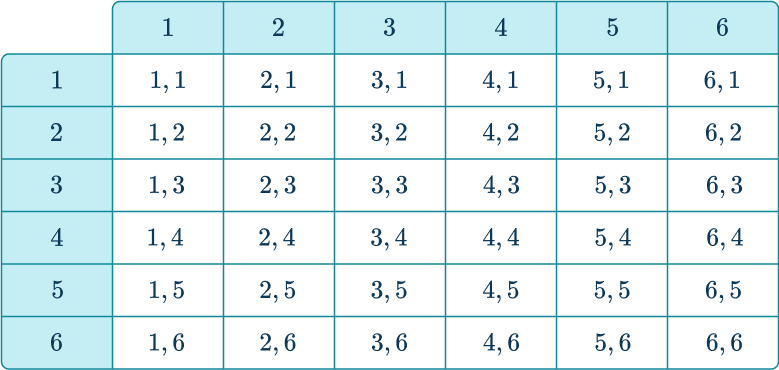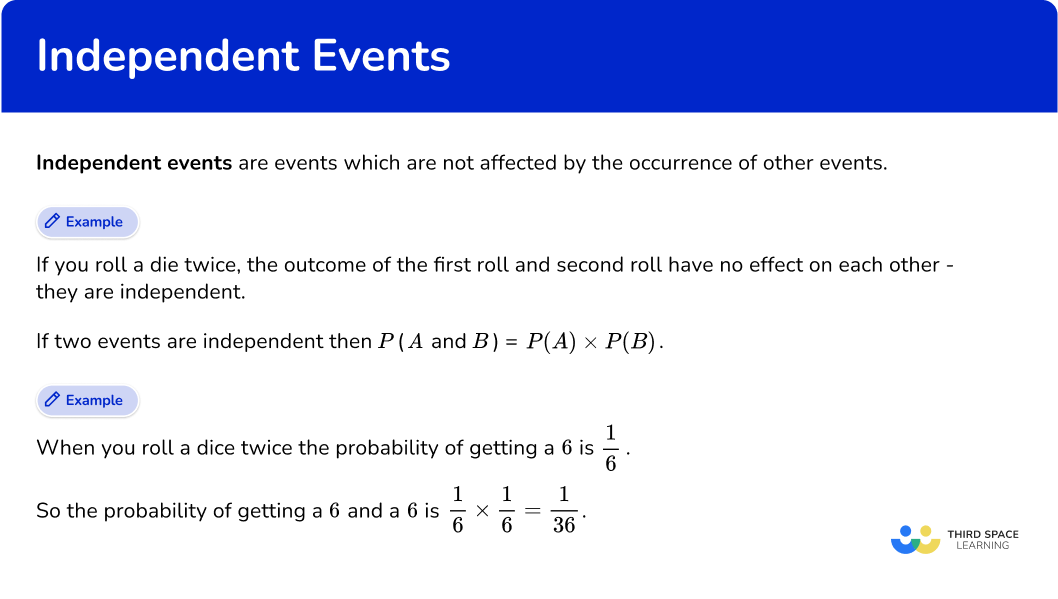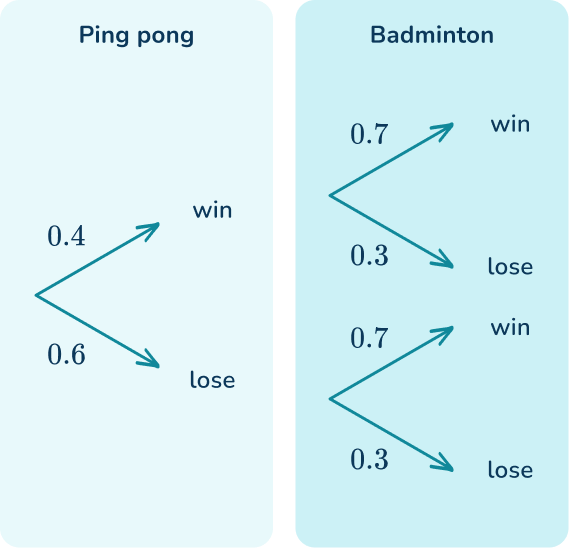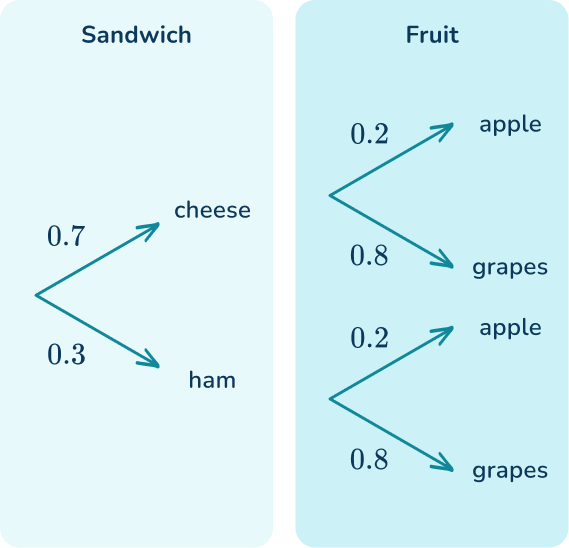High Impact Tutoring Built By Math Experts
Personalized standards-aligned one-on-one math tutoring for schools and districts
In order to access this I need to be confident with:
Multiplying and dividing fractions Multiplying and dividing decimals Tree diagram probabilityIndependent events
Here you will learn about independent events, including what independent events are and how to calculate the probability of independent events occurring.
Students will first learn about independent events as part of statistics and probability in 7 th grade and continue to learn about them in high school.
What are independent events?
Independent events are events whose probability of occurrence is not affected by other events.
For example, if you roll a die twice, the outcome of the first roll and second roll have no effect on each other – they are independent. The chances of rolling a 1, \; 2, \; 3, \; 4, \; 5 or 6 are the same on each roll, as shown in the table.

If two events are independent then P(A \text { and } B)=P(A) \times P(B).
This is called the multiplication rule.
Let’s look at an example.
If you are rolling a dice twice, we can find the probability of getting two sixes.
The probability of getting a 6 is \cfrac{1}{6}.
So the probability of getting a 6 and a 6 is \cfrac{1}{6} \times\cfrac{1}{6} = \cfrac{1}{36}.
What are independent events?

Common Core State Standards
How does this relate to 7 th grade math and 5 th grade math?
- Grade 7 – Statistics and Probability (7.SP.C.8)
Find probabilities of compound events using organized lists, tables, tree diagrams, and simulation.
- Statistics and Probability – Conditional Probability and the rules of Probability (HS.S.CP.A.2)
Understand that two events A and B are independent if the probability of A and B occurring together is the product of their probabilities, and use this characterization to determine if they are independent.
![[FREE] Probability Worksheet (Grade 7 to 12)](https://thirdspacelearning.com/wp-content/uploads/2023/07/Probability-check-for-understanding-quiz-listing-image.png)
[FREE] Probability Worksheet (Grade 7 to 12)
![[FREE] Probability Worksheet (Grade 7 to 12)](https://thirdspacelearning.com/wp-content/uploads/2023/07/Probability-check-for-understanding-quiz-listing-image.png)
Use this quiz to check your grade 7 to 12 students’ understanding of probability. 15+ questions with answers covering a range of 7th to 12th grade probability topics to identify areas of strength and support!
DOWNLOAD FREE![[FREE] Probability Worksheet (Grade 7 to 12)](https://thirdspacelearning.com/wp-content/uploads/2023/07/Probability-check-for-understanding-quiz-listing-image.png)
[FREE] Probability Worksheet (Grade 7 to 12)
![[FREE] Probability Worksheet (Grade 7 to 12)](https://thirdspacelearning.com/wp-content/uploads/2023/07/Probability-check-for-understanding-quiz-listing-image.png)
Use this quiz to check your grade 7 to 12 students’ understanding of probability. 15+ questions with answers covering a range of 7th to 12th grade probability topics to identify areas of strength and support!
DOWNLOAD FREEHow to calculate the probability of independent events
In order to calculate the probability of independent events:
- Confirm that the events are independent.
- Identify the probabilities of the events.
- Multiply the probabilities.
Independent event examples
Example 1: identifying independent events
Look at the events below. Which are examples of independent events?
- Rolling a die and getting a 6 and tossing a coin and getting a head.
- Tossing two coins and getting two heads.
- Choosing a green marble from a bag containing blue and yellow marbles and then choosing another green marble from the same bag.
- A student in Mr. Lopez’s class has brown hair and shoe size 6.
The definition of independence is that the events have no effect on each other.
When you roll a die and toss a coin, the outcome of one does not affect the outcome of the other therefore, the events are independent.
When you toss two coins, the outcome of one coin toss does not affect the other therefore, the events are independent.
When you choose a marble from a bag, you are changing the number of marbles in the bag, and therefore, the outcome of choosing the first marble will have an effect on the outcome of the second drawing for the second marble.
For example, if you choose a green marble the first time, the probability of choosing a green marble the second time will decrease. Therefore, these are dependent events.
The color of someone’s hair does not affect the size of their feet therefore, the events are independent.
Example 2: probability of two independent events
The probability that Tom forgets his homework is 0.3. The probability that Noah forgets his homework is 0.1. The events are independent. Calculate the probability that both Tom and Noah forget their homework on the same day.
Confirm that the events are independent.
You are told in the question that the events are independent.
Identify the probabilities of the events.
The first event is that Tom forgets his homework. The probability that Tom forgets his homework is 0.3.
The second event is that Noah forgets his homework. The probability that Noah forgets his homework is 0.1.
Multiply the probabilities.
The probability that Tom and Noah both forget their homework is
0.3 \times 0.1 = 0.03.
Example 3: probability of three independent events
Rachel tosses three fair coins. Find the probability that all three coins land on tails.
Confirm that the events are independent.
The outcome for each coin is not affected by the other coins therefore, the events are independent.
Identify the probabilities of the events.
Since the coins are fair, for each coin, the probability that it lands on tails is \cfrac{1}{2}.
Multiply the probabilities.
The probability of getting three tails is \cfrac{1}{2} \times \cfrac{1}{2} \times \cfrac{1}{2} = \cfrac{1}{8}.
Example 4: using a tree diagram
Niamh plays a game of ping pong on Saturday and a game of badminton on Sunday. The different outcomes are represented on the tree diagram below.

Calculate the probability that Niamh wins both games.
Confirm that the events are independent.
The outcome of one game does not affect the outcome of the other game therefore, the events are independent.
Identify the probabilities of the events.
The probability that Niamh wins ping pong is 0.4 and the probability that Niamh wins badminton is 0.7.
Multiply the probabilities.
The probability that Niamh wins ping pong and badminton is 0.4 \times 0.7=0.28.
Example 5: finding the probability of individual events
Zainab has two bags of mixed candy. She picks one candy from each bag. The probability that Zainab picks a lollipop from the first bag is \cfrac{1}{6} and the probability that she picks a lollipop from both bags is \cfrac{1}{15}. What is the probability that she picks a lollipop from the second bag?
Confirm that the events are independent.
The type of candy that is picked from one bag has no effect on the candy picked from the other bag therefore, the events are independent.
Identify the probabilities of the events.
The probability that Zainab picks a lollipop from the first bag is \cfrac{1}{6} and the probability that she picks a lollipop from both bags is \cfrac{1}{15}.
Multiply the probabilities.
If you call the probability of picking a lollipop from the second bag P(L) then \cfrac{1}{6} \times \text{P(L)}=\cfrac{1}{15}.
Solving this:
Example 6: finding the probability of individual events
Rosie flips a biased coin twice. The probability that Rosie gets two heads is 0.64. Find the probability that Rosie gets a head on a single coin flip.
Confirm that the events are independent.
The results of the first coin flip will not affect the second coin flip, so the events are independent.
Identify the probabilities of the events.
Here, you only know that the probability that Rosie gets two heads is 0.64.
Multiply the probabilities.
If you call the probability that Rosie gets a head P(H) then,
P(H) \times P(H)=0.64
Solving this:
The probability of getting a head on a single coin flip is 0.8.
Teaching tips for independent events
- Let students experience independent events in the classroom, but using examples that involve dice, coins, cards, marbles and other commonly found objects.
- Have students explore the sample spaces of independent events before introducing the rule. Many students will figure out the multiplication rule without being told. And even if they don’t, they will have more than one strategy to utilize when solving.
Easy mistakes to make
- Multiplying or dividing fractions incorrectly
To multiply fractions, multiply the numerators and multiply the denominators.
To divide fractions, find the reciprocal of the second fraction and multiply.
- Adding probabilities instead of multiplying them
For independent events P(A \text { and } B)=P(A) \times P(B).
For mutually exclusive events P(A \text { or } B)=P(A) + P(B).
Practice independent events questions
1. Identify the pair of events that are not independent.
Rolling two dice and each landing on 6.

Rain falling on 20 th December 2020 and 20 th December 2021.

Flipping a coin and landing on tails and picking a king from a deck of cards.

Picking one card from a deck of cards and then a second card and getting an ace both times.

If you choose one card from a deck of cards, you are changing the number of cards left and therefore the probabilities of each outcome for the next draw.
Picking the first card followed by a second card from a deck of cards are not independent events.
2. Events A and B are shown below.
Event A – rolling a die and landing on an even number.
Event B – picking a diamond from a deck of cards.
Felicity rolls a die and picks a card from a deck of cards. Find the probability of both events A and B occurring.




The events are independent, because one outcome does not affect the other.
The probability of a die landing on an even number is \cfrac{1}{2}.
The probability of picking a diamond from a deck of cards is \cfrac{1}{4}.
The probability of events A and B both occurring is \cfrac{1}{2} \times \cfrac{1}{4} = \cfrac{1}{8}.
3. The probability that my train is late on any given day is 0.3. Find the probability that my train is late three days in a row.




The events are independent, because one outcome does not affect the other.
The probability that the train is late on any one day is 0.3.
The probability that the train is late on day 1 and day 2 and day 3 is 0.3 \times 0.3 \times 0.3 = 0.027.
4. Sam has different options for her lunch. The probabilities of her choosing the different options are shown below.

Find the probability that Sam chooses a cheese sandwich and grapes.




The events are independent, because one outcome does not affect the other.
The probability that Sam chooses a cheese sandwich is 0.7 and the probability that Sam chooses grapes is 0.8.
The probability that Sam chooses a cheese sandwich and grapes is 0.7 \times 0.8=0.56.
5. Sheila and Pete are playing darts. The probability that Sheila hits a bullseye is 0.1 and the probability that they both hit a bullseye is 0.02. Find the probability that Pete hits a bullseye.




The events are independent, because one outcome does not affect the other.
If you call the probability that Pete hits a bullseye P(P) then
\begin{aligned}0.1 \times \text{P(P)}&=0.02 \\\\ \text{P(P)}&=0.02 \div 0.1 \\\\ &=0.2 \end{aligned}
6. Marwa rolls a biased die twice. The probability that she gets two sixes is \cfrac{4}{25}.
Find the probability that Marwa rolls a six on any one roll.




The events are independent, because one outcome does not affect the other.
If you call the probability of rolling a six P(6) then
\begin{aligned}\text{P(6)} \times \text{P(6)}&=\cfrac{4}{25} \\\\ \text{(P(6))}^{2}&=\cfrac{4}{25} \\\\ \text{P(6)}&=\sqrt{\cfrac{4}{25}} \\\\ \text{P(6)}&=\cfrac{2}{5} \end{aligned}
Independent events FAQs
The sample space is the set of all possible outcomes in a probability experiment.
This is conditional probability and there are various theorems and formulas for calculating, depending on the circumstances.
The next lessons are
- Compound probability
- Probability distribution
- Units of measurement
Still stuck?
At Third Space Learning, we specialize in helping teachers and school leaders to provide personalized math support for more of their students through high-quality, online one-on-one math tutoring delivered by subject experts.
Each week, our tutors support thousands of students who are at risk of not meeting their grade-level expectations, and help accelerate their progress and boost their confidence.

Find out how we can help your students achieve success with our math tutoring programs.
[FREE] Common Core Practice Tests (3rd to 8th Grade)
Prepare for math tests in your state with these 3rd Grade to 8th Grade practice assessments for Common Core and state equivalents.
Get your 6 multiple choice practice tests with detailed answers to support test prep, created by US math teachers for US math teachers!